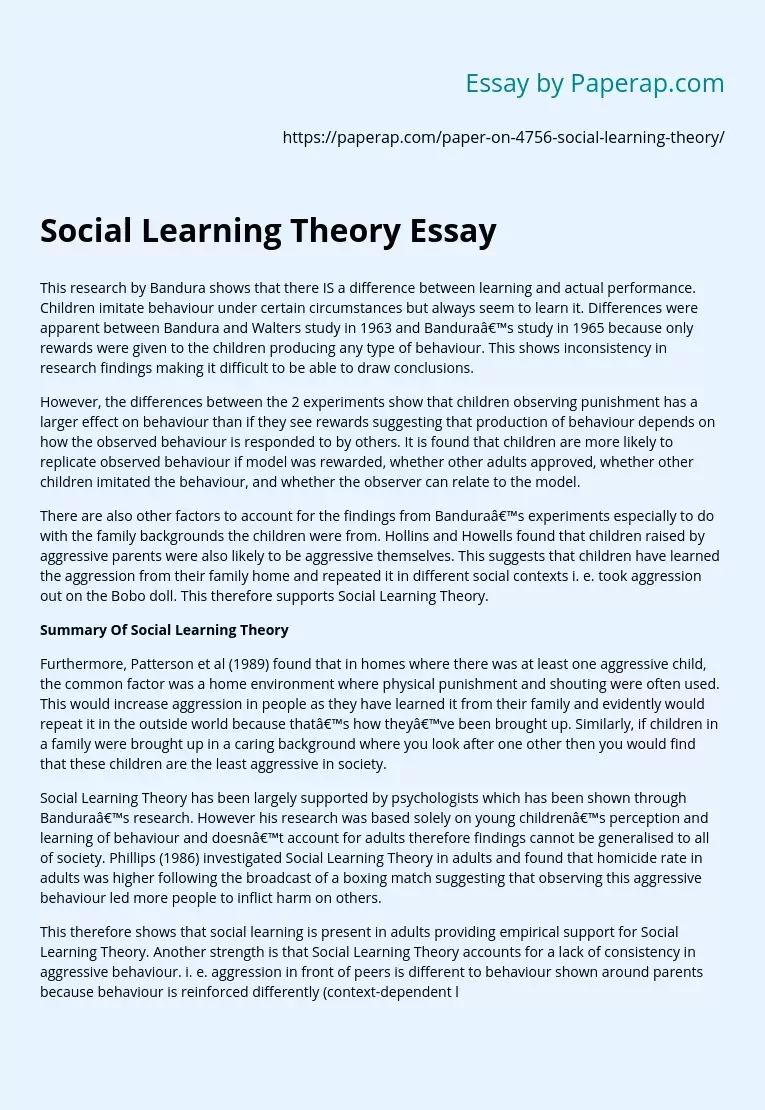Social Learning Theory Essay
This research by Bandura shows that there IS a difference between learning and actual performance. Children imitate behaviour under certain circumstances but always seem to learn it. Differences were apparent between Bandura and Walters study in 1963 and Bandura’s study in 1965 because only rewards were given to the children producing any type of behaviour. This shows inconsistency in research findings making it difficult to be able to draw conclusions.
However, the differences between the 2 experiments show that children observing punishment has a larger effect on behaviour than if they see rewards suggesting that production of behaviour depends on how the observed behaviour is responded to by others.
It is found that children are more likely to replicate observed behaviour if model was rewarded, whether other adults approved, whether other children imitated the behaviour, and whether the observer can relate to the model.
There are also other factors to account for the findings from Bandura’s experiments especially to do with the family backgrounds the children were from.
Hollins and Howells found that children raised by aggressive parents were also likely to be aggressive themselves. This suggests that children have learned the aggression from their family home and repeated it in different social contexts i. e. took aggression out on the Bobo doll. This therefore supports Social Learning Theory.
Summary Of Social Learning Theory
Furthermore, Patterson et al (1989) found that in homes where there was at least one aggressive child, the common factor was a home environment where physical punishment and shouting were often used.
This would increase aggression in people as they have learned it from their family and evidently would repeat it in the outside world because that’s how they’ve been brought up. Similarly, if children in a family were brought up in a caring background where you look after one other then you would find that these children are the least aggressive in society.
Social Learning Theory has been largely supported by psychologists which has been shown through Bandura’s research. However his research was based solely on young children’s perception and learning of behaviour and doesn’t account for adults therefore findings cannot be generalised to all of society. Phillips (1986) investigated Social Learning Theory in adults and found that homicide rate in adults was higher following the broadcast of a boxing match suggesting that observing this aggressive behaviour led more people to inflict harm on others.
This therefore shows that social learning is present in adults providing empirical support for Social Learning Theory. Another strength is that Social Learning Theory accounts for a lack of consistency in aggressive behaviour. i. e. aggression in front of peers is different to behaviour shown around parents because behaviour is reinforced differently (context-dependent learning).
Social Learning Theory also accounts for cultural differences in aggressive behaviour, i. e. individualistic cultures are more aggressive than collectivistic cultures because individuals learn from others how to look after themselves and how to survive. However, Bandura was criticised on the grounds that the television programmes he used in his experiments were not representative of the programmes at the time therefore again lacks ecological validity. It is also highly unethical to manipulate child’s behaviour as they probably did not give informed consent even though parents allowed them to participate.
Social Learning Theory has also been largely criticised by biological researchers. They argue that the theory completely ignores individual’s biological state. “they state that the social learning theory rejects the differences of individuals due to genetic, brain, and learning differences” (Jeffrey, 1985: p. 238) The effect of the media on aggression has also been widely researched. Aggression ideas shown by the media, influences people to observe, learn and imitate the behaviour.
However, evidence for this is inconclusive. Media may simply be a contributing factor, all the other factors like family background and individual differences could account for peoples levels of aggression. In conclusion, Social Learning Theory as an explanation of aggression ignores that aggression can be innate and the amount of arousal within the person at the time can affect behaviour largely. However, the theory is largely supported in psychology as is demonstrated through Bandura’s work with the Bobo dolls.
“These experiments demonstrate conclusively that the acquisition and production of aggression is socially mediated. ” (Cardwell and Flanagan, 2004: p. 37).
References
Bandura, A. (1962). Social Learning through Imitation. University of Nebraska Press: Lincoln, NE. Bandura, 1973. cited on http://www. criminology. fsu. edu/crimtheory/bandura. htm. Accessed on 1st November 2005. Website used for various information. Bandura, A. , & Walters, R. H. (1959). Adolescent Aggression. Ronald Press: New York: http://mentalhelp.net.
Social Learning Theory Essay. (2019, Dec 05). Retrieved from https://paperap.com/paper-on-4756-social-learning-theory/

